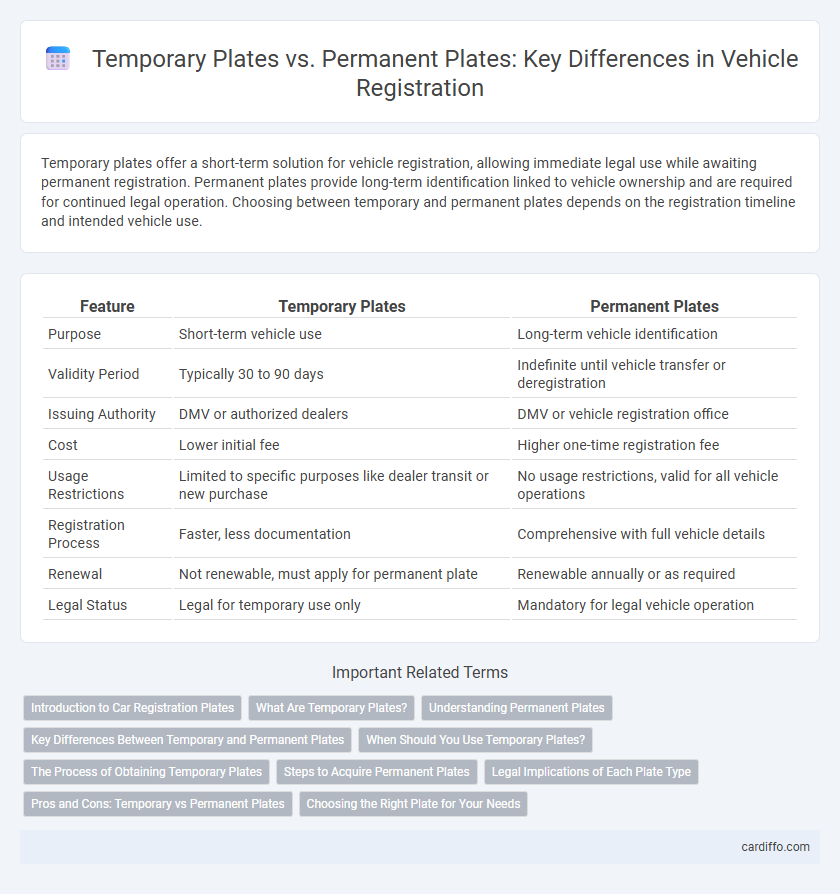Temporary plates offer a short-term solution for vehicle registration, allowing immediate legal use while awaiting permanent registration. Permanent plates provide long-term identification linked to vehicle ownership and are required for continued legal operation. Choosing between temporary and permanent plates depends on the registration timeline and intended vehicle use.
Table of Comparison
| Feature | Temporary Plates | Permanent Plates |
|---|---|---|
| Purpose | Short-term vehicle use | Long-term vehicle identification |
| Validity Period | Typically 30 to 90 days | Indefinite until vehicle transfer or deregistration |
| Issuing Authority | DMV or authorized dealers | DMV or vehicle registration office |
| Cost | Lower initial fee | Higher one-time registration fee |
| Usage Restrictions | Limited to specific purposes like dealer transit or new purchase | No usage restrictions, valid for all vehicle operations |
| Registration Process | Faster, less documentation | Comprehensive with full vehicle details |
| Renewal | Not renewable, must apply for permanent plate | Renewable annually or as required |
| Legal Status | Legal for temporary use only | Mandatory for legal vehicle operation |
Introduction to Car Registration Plates
Car registration plates serve as official identifiers issued by government authorities to vehicles, distinguishing between temporary plates used for short-term circulation and permanent plates assigned for long-term vehicle identification. Temporary plates typically feature limited validity and are often issued during the period between purchase and formal registration, while permanent plates are linked to the vehicle's registration record and remain consistent throughout its ownership. Understanding the distinction between temporary and permanent plates is essential for compliance with legal requirements and proper vehicle identification.
What Are Temporary Plates?
Temporary plates are short-term license tags issued by motor vehicle departments to allow legal operation of a vehicle before permanent registration is finalized. These plates typically expire within 30 to 90 days, providing time for the vehicle owner to complete necessary paperwork and pay registration fees. Temporary plates display unique identification numbers and must be clearly visible to law enforcement during the interim period.
Understanding Permanent Plates
Permanent plates provide long-term vehicle identification and registration linked to the owner's records in the Department of Motor Vehicles (DMV). They are made of durable materials designed to withstand weather conditions and are typically valid for multiple years without replacement. Unlike temporary plates, permanent plates ensure consistent legal compliance and facilitate law enforcement tracking throughout the vehicle's lifespan.
Key Differences Between Temporary and Permanent Plates
Temporary plates serve as short-term vehicle identification permits issued for a limited period, typically 30 to 90 days, allowing legal operation while awaiting permanent registration. Permanent plates are durable, long-lasting metal or plastic tags assigned to a vehicle's lifetime registration, featuring unique alphanumeric codes for official identification. The primary differences lie in their validity duration, material quality, and legal usage scope, with temporary plates designed for interim compliance and permanent plates for continuous vehicle identification.
When Should You Use Temporary Plates?
Temporary plates should be used when you purchase a new or used vehicle and need legal permission to drive it before receiving permanent registration. They are especially important for transferring ownership, moving a vehicle between states, or test-driving before final registration. Temporary plates typically expire within 30 to 90 days, allowing sufficient time to complete all permanent registration paperwork.
The Process of Obtaining Temporary Plates
Obtaining temporary plates involves submitting a vehicle registration application to the local Department of Motor Vehicles (DMV) or relevant authority, accompanied by proof of ownership, identification, and payment of applicable fees. Temporary plates are typically issued immediately or within a few business days, allowing legal vehicle operation while awaiting permanent plates. This process ensures compliance with vehicle registration regulations and provides short-term legal identification for the vehicle.
Steps to Acquire Permanent Plates
To acquire permanent plates, vehicle owners must first complete the registration application form and submit required documents such as proof of ownership, identity, and insurance. Next, payment of applicable fees is necessary, followed by a vehicle inspection if mandated by local regulations. Once these steps are fulfilled, permanent plates are issued, replacing any temporary plates previously assigned.
Legal Implications of Each Plate Type
Temporary plates are legally valid for a limited period, typically ranging from 30 to 90 days, allowing new vehicle owners to operate their vehicles while awaiting permanent registration. Permanent plates provide long-term legal identification, ensuring compliance with state vehicle registration laws and facilitating law enforcement tracking. Failure to display the correct plate type within the designated timeframe can result in fines, vehicle impoundment, or other legal penalties.
Pros and Cons: Temporary vs Permanent Plates
Temporary plates offer quick vehicle identification and ease of use during short-term ownership or pending permanent registration, but they often have limited validity and may be subject to extra fees or restrictions. Permanent plates provide long-term identification, lower replacement frequency, and increased legality for official vehicle use, yet they require full registration processing and may involve higher initial costs. Choosing between temporary and permanent plates depends on the duration of use and compliance requirements established by state motor vehicle departments.
Choosing the Right Plate for Your Needs
Temporary plates provide short-term vehicle identification, ideal for new purchases or transfers, offering immediate legality while awaiting permanent tags. Permanent plates ensure long-term registration, typically made of durable materials with unique alphanumeric codes, essential for consistent vehicle identification and compliance. Assess the duration of use, legal requirements, and registration timelines to determine whether temporary or permanent plates best suit your specific driving and administrative needs.
Temporary Plates vs Permanent Plates Infographic

 cardiffo.com
cardiffo.com